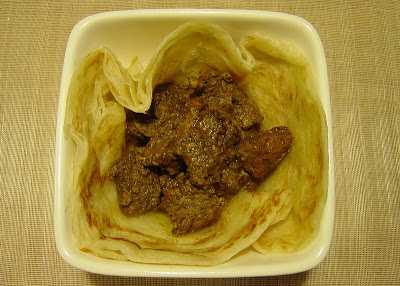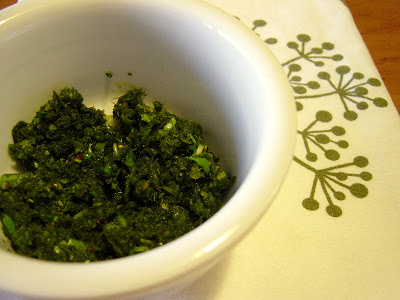
It’s always a pleasure to meet and fall in love with a new herb. The smelling…the tasting. Running your hands through its leaves then holding them up to your face and inhaling deeply, filling your lungs with the scent of your new herby love. Scouring cookbooks, magazines, and the internet for information. Trying it in new recipes and discovering new flavor combinations. Seeing how it fits with this food or that ingredient. A blissful journey filled with surprises.
That’s how I felt the first time I met culantro. I already loved cilantro, but culantro was so much more. Its flavor and scent were more intense. In fact, when you cook with it, the ghost of its scent lingers everywhere. You can read about culantro and my discovery of it here. I first used it in a Vietnamese style soup. Then C added it in a typical local salad of tomatoes, onions, and bagoong (shrimp paste). In both cases this wonderful herb performed outstandingly. After these more Asian-inspired dishes, I wanted to try something from where culantro originated – the West Indies. I had never cooked anything from the Caribbean and this was too good an opportunity to pass up, so I look over my March 2006 issue of Saveur where I found a lot of culantro-info in a feature on Trinidad.
Perusing the article (and getting swept away in my desire to visit Carnival!) and all the recipes included, a recipe for a dish called Geera Pork kept tugging at me in that insistent “Make me!” way that some recipes have. The recipe sounded tempting enough, using culantro, garlic, parsley, thyme, spring onions, allspice, cumin, and garam masala. So Geera Pork it was! I changed the quantities somewhat to suit what I had, as well as up the quantity of certain flavors. I also used pork steak instead of pork loin (more fat…heehee).
Geera Pork (Curried Pork)
(adapted from Saveur March 2006, page 73)
- 500 grams pork steak, cut in 1 inch pieces
- 4 cloves garlic, peeled
- 2 spring onions, chopped
- 2 ½ tablespoons chopped culantro
- 1 tablespoon chopped fresh parsley
- 1 tablespoon fresh thyme leaves
- ½ tablespoon ground allspice
- Freshly ground pepper
- Salt
- ¼ cup canola oil
- 2 tablespoons garam masala dissolved in ½ cup water
- 1 tablespoon ground cumin
- 1 sili labuyo (bird’s eye chilli) – original recipe called for scotch bonnet or jabanero
– Place garlic, spring onions, culantro, parsley, thyme, and 1/8 cup water in a food processor, or the bowl of an immersion blender, and process until mixture is smooth.
– Transfer to a bowl and add the pork, allspice, pepper, and salt to taste. Toss to coat well, cover with plastic wrap, and refrigerate for at least 4 hours or overnight.
– When you are ready to cook the pork, heat oil in a heavy-bottomed pot with a tight-fitting lid over medium heat. Add the garam masal mixture (carefully!) and cook, stirring occasionally, until thickened.
– Add pork and stir to coat well. Reduce the heat, cover, and simmer until pork is almost cooked, about 20 minutes.
– Toss in chilies and cumin and give it a stir. Cover and simmer until pork is tender, about 45 minutes to an hour. Uncover and cook until liquid has reduced to a thick paste. Add salt to taste if needed.
– Garnish with more chopped culantro.
In Trinidad, this is usually sold on the streets in small cups and eaten with Buss-Up-Shut, a Trinidad version of roti. Buss-Up-Shut takes its name from its appearance – looking like a “busted-up shirt”…now how adorable is that? Despite its cute name, I didn’t have time to make the Buss-Up-Shut, so instead ate it in a bowl lined with roti. It was definitely a new flavor for me! Well, actually more like a new dimension to an old flavor. It had the taste of the curries I’ve had before, but with a sharp new note…green and bright and strong…the culantro making its presence felt. C, who chose to eat it with rice, also liked it, saying that it “tastes like curry…but different”. It’s the same feeling you get when you travel to a new place and sense something familiar along with the exotic.

I still had culantro left after this, and I had to use it up fast, so I decided to make Chadon Beni Sauce, another recipe from the same article. Chadon Beni Sauce is basically culantro sauce and is used to make lots of curries in Trinidad and around. I cleaned and chopped my remaining culantro and ended up with 1 cup. To this I added 3 chopped spring onions, ½ a sili labuyo (bird’s eye chilli), and two cloves of peeled garlic. I blitzed the whole lot with my immersion blender until it formed a rough paste, and seasoned to taste with salt. I put this in a ziplock bag and popped it in the freezer for future use. Perhaps for Chicken Pelau, another Trinidadian dish. I’m not over with the Caribbean just yet.

As this entry really centered on my discovery of, and subsequent captivation with, this delicious herb culantro, I am submitting it to this weekend’s round of Weekend Herb Blogging (my first time to join!). This event was started by the fantastic Kalyn of Kalyn’s Kitchen and is hosted this week by Anna of Anna’s Cool Finds.
chichajo….not only did it pass with my trini boyfriend, i am now making huge batches of the seasoning for freezing and up til christmas he had me making it every weekend for him to carry home an to work lol! by the way – i always use chicken in this recipe instead of pork for him…boneless skinless chicken breast cut up same way as you would the pork. sometimes i do a pot of each…can't thank you enough for posting this recipe!
Hi Anonymous! You are very welcome and I'm glad to be of help 🙂 So happy that you and your boyfriend really like it! I do to 🙂
I do salivate whenever you took photos. You have a very keen eye for details! Kudos!